Water levels dropped significantly overnight in parts of southern New Brunswick, raising hopes in the flood-ravaged province that there is finally “light at the end of the tunnel,” emergency officials said Tuesday.
“The river is going down, it is going down at all points between Fredericton and Saint John,” said Geoffrey Downey, a spokesperson for the New Brunswick Emergency Measures Organization.
Flood waters in Fredericton, for example, dropped from the 8-metre mark to 7.4 metres, Downey said.
Water levels have also dropped in other communities impacted by the unprecedented flooding in the St. John River basin.
“Right now this is a one-day thing, it’s very promising, the forecast is promising both in terms of the water level and how much rain we’re supposed to get in the coming days,” Downey said.
“If we can get two days in the row where the river has dropped noticeably, then we can probably start thinking about whether we’re in a position where will keep dropping and dropping and dropping.”
‘Start of a long process’

Sailors prepare to secure a work boat at the Royal Kennebecasis Yacht Club in Saint John, N.B. on Saturday, May 5, 2018. Swollen rivers across New Brunswick are still rising, flooding streets and properties and forcing people from their homes in several communities. (Andrew Vaughan/THE CANADIAN PRESS)
Once the water level has dropped enough, residents will be able to get to their homes to assess the damage, he said.
“As much as everyone will be happy to see the river back down to normal levels, this is the start of a long process,” Downey said.
“The recovery is going to take a long time both for governments, where for example highway infrastructure has been damaged, for cities where city roads have been damaged and maybe even city buildings, and then of course property owners.”
People have to prepare themselves for tough times ahead, he said.
“There is a number of homeowners who are going to get home and find out that there has been considerable damage,” Downey said.
The provincial authorities are also warning residents to remain vigilant even after the water levels recede.
Flooded roads need to be inspected

A resident paddles his canoe at Darlings Island, N.B. on Thursday, May 3, 2018 as the Kennebecasis River flooded the only road into the community. (Andrew Vaughan/THE CANADIAN PRESS)
Provincial and municipal authorities have to check whether roads that have been submerged for days are still structurally sound.
“As far as homeowners, there will be things like the water that’s been in their home could have been full of sewage, full of all kinds of contaminants,” Downey said. “They may all kinds of debris that have been swept up anywhere from tree trunks to propane tanks, to who knows what that has been flowing down the river.”
It is essential that affected residents take the precautions necessary to reduce possible risks to their health and that of their family, said Dr. Jennifer Russell, the province’s chief medical officer of health.
People should wear rubber boots and waterproof gloves during cleanup, especially if they suspect sewage contamination, Russel said.
Contaminated water supply

A man carries a bag of clothing before leaving his home as floodwaters from the Saint John River continue rising in Grand Lake, N.B. on Wednesday, May 2, 2018. (Darren Calabrese/THE CANADIAN PRESS)
Residents who rely on well water should be aware that private water supplies contaminated by flooding should not be used while the wellhead is flooded, authorities warned.
Once flood waters have receded, the well should be disinfected and water quality should be tested prior to use.
Water quality may also be affected by chemicals such as furnace oil, gasoline or agricultural chemicals. In such cases residents should not use the water, even if it has been boiled, authorities warned.
The provincial government is providing free testing for water from private wells that have been directly affected by recent flooding. Beginning May 17, water sampling kits will be available at Service New Brunswick Centres for owners of private wells. Residents must wait 10 days after water has receded from the well area before beginning the chlorination and sampling process, authorities said in a press release.







For reasons beyond our control, and for an undetermined period of time, our comment section is now closed. However, our social networks remain open to your contributions.